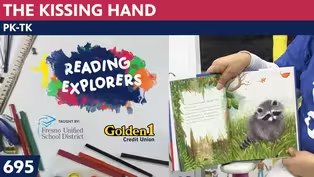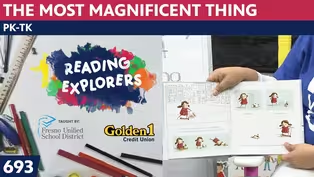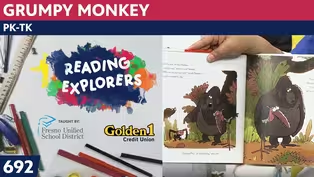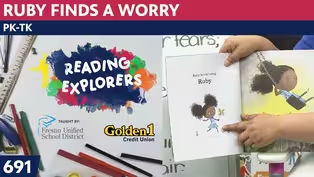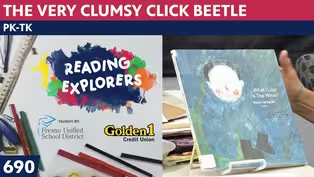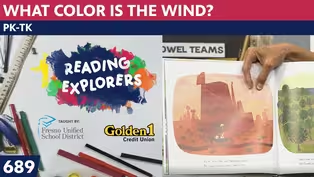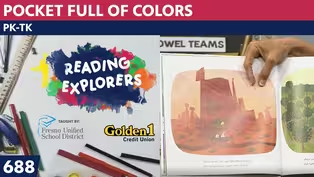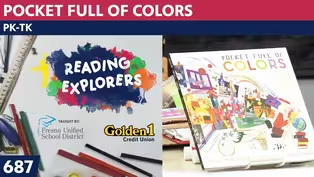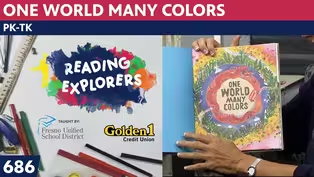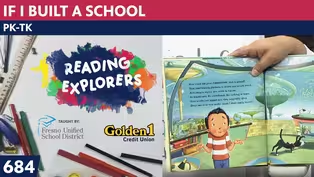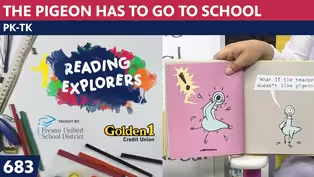
TK-326: Faith Ringgold
Season 3 Episode 132 | 14m 10sVideo has Closed Captions
Join Mrs. Readwright at Camp Discovery!
Transitional Kindergarten teacher, Mrs. Readwright, welcomes students back to Camp Discovery, a fun learning space packed with reading adventures & fun games!
Problems playing video? | Closed Captioning Feedback
Problems playing video? | Closed Captioning Feedback
Reading Explorers is a local public television program presented by Valley PBS

TK-326: Faith Ringgold
Season 3 Episode 132 | 14m 10sVideo has Closed Captions
Transitional Kindergarten teacher, Mrs. Readwright, welcomes students back to Camp Discovery, a fun learning space packed with reading adventures & fun games!
Problems playing video? | Closed Captioning Feedback
How to Watch Reading Explorers
Reading Explorers is available to stream on pbs.org and the free PBS App, available on iPhone, Apple TV, Android TV, Android smartphones, Amazon Fire TV, Amazon Fire Tablet, Roku, Samsung Smart TV, and Vizio.
Providing Support for PBS.org
Learn Moreabout PBS online sponsorshipMore from This Collection
Valley PBS and Fresno Unified School District have partnered with Golden 1 Credit Union to create Reading Explorers Lessons for grades Pre-Kindergarten through Third grade. The daily lessons will be taught by Fresno Unified School District teachers and are created to help students practice their reading skills and reinforce lessons during distance learning.
Video has Closed Captions
Valley PBS presents Reading Explorers Lessons for Pre-Kindergarten and TK. (26m 27s)
PK-TK-693-The Most Magnificent Thing
Video has Closed Captions
Valley PBS presents Reading Explorers Lessons for Pre-Kindergarten and TK. (26m 26s)
Video has Closed Captions
Valley PBS presents Reading Explorers Lessons for Pre-Kindergarten and TK. (26m 28s)
Video has Closed Captions
Valley PBS presents Reading Explorers Lessons for Pre-Kindergarten and TK. (26m 28s)
PK-TK-690: The Very Clumsy Click Beetle
Video has Closed Captions
Valley PBS presents Reading Explorers Lessons for Pre-Kindergarten and TK. (26m 22s)
PK-TK-689: What Color is the Wind?
Video has Closed Captions
Valley PBS presents Reading Explorers Lessons for Pre-Kindergarten and TK. (26m 21s)
PK-TK-688: Pocket Full of Colors
Video has Closed Captions
Valley PBS presents Reading Explorers Lessons for Pre-Kindergarten and TK. (25m 58s)
PK-TK-687: Dancing Through Fields of Colors
Video has Closed Captions
Valley PBS presents Reading Explorers Lessons for Pre-Kindergarten and TK. (26m 20s)
PK-TK-686: One World Many Colors
Video has Closed Captions
Valley PBS presents Reading Explorers Lessons for Pre-Kindergarten and TK. (27m 13s)
PK-TK-685: School is Wherever I am
Video has Closed Captions
Valley PBS presents Reading Explorers Lessons for Pre-Kindergarten and TK. (26m 32s)
PK-TK-684: If I Built a School
Video has Closed Captions
Valley PBS presents Reading Explorers Lessons for Pre-Kindergarten and TK. (26m 21s)
PK-TK-683: The Pigeon Has to Go to School
Video has Closed Captions
Valley PBS presents Reading Explorers Lessons for Pre-Kindergarten and TK. (26m 22s)
Providing Support for PBS.org
Learn Moreabout PBS online sponsorship♪ Good morning to a brand new day ♪ ♪ Time to learn and games to play ♪ ♪ Learning things is so much fun ♪ ♪ Learning is good for everyone ♪ (upbeat music) (playful music) - Hello, early learners.
It's me, Mrs. Readwright.
I'm here to welcome you back to the art room.
We're going to be studying a new artist all week long, one artist.
And I don't want to tell you too much yet, because I'm going to reveal it inside the mystery suitcase.
So let's start out with our hello song.
♪ Hello, nice to see you, everyone ♪ ♪ Hello, nice to see you, everyone ♪ ♪ Hello to you, hello to you ♪ ♪ Hello to you, hello to me ♪ ♪ Hello, nice to see you everyone ♪ All right, Mystery Monday.
What is inside the suitcase?
The first thing I want to show you is this piece of fabric.
What country do you think this might be from?
It has the colors of the flag.
This is kente cloth, and it's to show you our artist is from Africa, or she's an African American.
She's an American woman, because she was born in the United States.
She was born in Harlem.
But this is going to be here, and I think I'll put it on the table for tomorrow.
And let's see what else is in the suitcase.
It's a book about the kente cloth and talking about the patterns that are in the African fabric, and this is the book we're going to be talking about all week long.
It's called "Tar Beach."
Let's put that up here with her.
Oh, stay there, Mrs. Readwright.
And the last thing, she is an artist who painted, but she also used fabric.
So I brought a story quilt similar to what she might have made.
It has a border, just like her quilts do, and you might remember this.
I used this when it was Vincent van Gogh's bedroom, because we talked about a blanket being on his bed.
So here is a quilt, and that African fabric, and the book "Tar Beach," and I'm going to tell you what her name is.
Faith Ringgold.
Shall we take a look at a picture of her?
She's up on the blue chart, and this is a current picture of her.
She is older now.
This year, she will be 91 years old, and she's still doing art, and she still teaches at San Diego University.
And this is the picture of "Tar Beach 2."
So there's a "Tar Beach 1" and there are other "Tar Beaches," because she loved the idea.
Now, where she lived in New York, you could go up on the rooftop and have picnics up on there, and it's covered with a kind of black material called tar.
And it's similar to what's on the roads, but not with all of the rocks in it.
And in this painting, the inside is painted and the outside is fabric.
And she even writes words that explains what's going on in the pictures, and you can't see it in here, but if you check the book out from the library, you might be able to tell.
Now, look what's flying over the George Washington Bridge.
The bridge spans over some water, and it stands there tall as can be.
And here is Cassie Lightfoot and her brother Bebe flying over the George Washington Bridge.
But wait, what do you see below?
They are lying on a mattress on the rooftop.
Everyone's upstairs, her mama and daddy and the neighbors, and they're playing cards at the table.
Their laundry is hung up, their picnic is set up, but Cassie and her brother are looking up to the sky and seeing the stars there and watching all of the lit-up buildings at night as they lie there and relax.
This tall building has a person on top, and Faith Ringgold talks about that.
So this week we're going to start out by making the bridge, and we're gonna hang on to that, because the next day we're going to add the buildings, and we're going to hang on to that, because the third day we're going to make ourselves flying over the bridge.
Now, here is a picture of the George Washington Bridge at sunset.
You can see it's going over water, and the road carries cars across and under that bridge.
Now, there is a tall, tall piece that goes down to the water, and down below there, there are places that hold it above the water level, and then they light it up at night.
But I want to show you all of these have X's in them.
And when we draw it today, you'll say, "Oh, I need to put X's," but there's also an archway so that the cars can drive under.
Now, one of the things that Faith Ringgold says is "If one can, anyone can, all you gotta do is fly."
And we know that people can't fly just their bodies, they have to get in a plane or a helicopter, but she said, "Just dream of it, and dream of yourself flying somewhere."
So that's what Cassie Lightfoot does.
She flies over the bridge, and so I thought that was a great way to start our week is by making the bridge.
Now she was, I told you was born in Harlem, but she was sick as a little girl.
Every time she breathed in, it hurt her lungs, so her family kept her home, and they kept her home until second grade.
She was too sick to go to school.
She wouldn't make other people sick, but every time she walked, she was too weak.
So she stayed home and her mama taught her to read, and her mama taught her to sew, and her mama taught her all kinds of things because her mama was a dressmaker, and she was a designer of fabric.
So while Faith was sick, she would make frames out of fabric and give them to her, and she would paint inside.
And that's how she got really good at her art.
Let me set this down, and let's pick up my little tabletop.
Now, I'm using black paper today, and the reason I'm using black paper is because it will show the bridge at night better than if I used white paper, but you use what you have.
And here we go.
Now I'm using gray and white pencil, colored pencil.
And I also brought my white pen in case I wanted to use it, but you might not have one of these, but if you do, great.
I also brought glitter glue that I got at that store that you can get everything for a dollar.
And they also had some silver and gold glitter.
And I brought my silver and gold glitter glue, but I've never used it before until yesterday.
I don't know why I never used glitter glue, but I never have, and it takes forever to dry.
So I had to be careful with it.
So I thought, well, I just want to make the lights on the bridge shine.
So that's how I'm going to be using it.
I'm gonna set it over here so I don't knock it off while I'm trying to draw.
I brought a ruler, but I was going to tell you, if you don't have a ruler, just use the edge of a piece of cardboard, like that kind of cardboard that's on a cereal box.
You can just cut it and make it straight.
But here's how I'm going to start it.
I set my ruler down on the edge of my paper, and I'm going to use, I'm gonna show you what the gray looks like as I draw, but you can also use the white pencil.
If you don't have either of these, just use your crayon, your white crayon or a gray crayon.
Now I'm gonna start down on my paper some, so I can make a standing line, a good standing line.
Does the gray show up enough?
Not as good as I'd like, so I'm going to go back and use my white right on top of it.
You decide which one you like better.
Here's my white.
I'm going to make another line, the same distance away.
So I'm gonna turn this sideways so you can see.
I'm gonna make it the same size as that line.
So I say, is it right?
Yes.
And where am I stopping?
Right there.
So it's over and stop.
Now, I'm gonna put the other one over here, and I'm going to make it a little shorter, 'cause it's going to go across the water at a different place.
So a little bit shorter, but on the other line is going to be marked right with it.
If your lines aren't perfectly straight, do you think you need to worry about it?
No, now I'm going to make the archway that lets the cars drive through.
And then I'm going to draw a line across, where more X's will go, cross that way, cross that way, cross that way, and that, and then I can either just look at it and say where I think it should go, or I can measure it, but I'm just going to make some down like this, because I want all of my X's to be about the same size.
I'm only going to make them one layer of pencil right now.
But to make them show up a little better later, I might draw it over.
Let me show you what I mean.
I might go back and do this, make them a little darker by pressing on my pencil back and forth, back and forth, back and forth.
You'll see which way you like better on yours.
So I'm doing the X's all the way down, doing the X's all the way down here, and do you know what I'm going to do when I reach the bottom?
That's right, do it over here.
Gonna try and make it go across the same way.
Little bit here, little bit here.
And this has some straight up and down, above the arch, there's a V with one line up in the front.
Could do that.
Make my X here, make my X here.
Do my stripes across.
Stripes across, putting my X corner to corner, corner to corner.
When you're learning to make an X, you can just make a box and say corner to corner, 'cause sometimes if you're doing it just on your own, your X's get a little wonky.
You know what wonky means?
It's a made-up word for meaning crooked.
So there, I made it all the way to the bottom.
Now to make it across, there would be another one of these way over here.
But I'm going to start from here, and do a little bit of a curved line over, and from this side, a little bit of a curved line over, I'm making them both on there.
Now I want lights to go across, so I'm gonna make dots where I want to put my glue or my glitter.
So I'm gonna just put a few across.
I'm gonna put this one right across from it, this one across from it, this one across from it.
And that looks pretty good.
Here they have some straight lines and some X's, so I'll put those in there too.
So I looked at the picture, and it shows all of that on the picture, I looked at the George Washington Bridge.
And if you want to look up the George Washington Bridge and make it even more like it, 'cause I'm just making what I think it looks like.
Now I'm going to put my pencils over here and my ruler, 'cause I don't need it, but I am grabbing this silver glue.
There were four colors in that box that I got at that store that's everything for a dollar, and there's a red one.
Ooh, squeeze and make a dot.
It's making the lights look sparkly.
That's just what I wanted.
Now, I told you, this does not dry quickly.
It took almost four hours for it to dry, so I'm just going to leave it like this and not bother with it.
So I want to tell you about tomorrow.
Save this picture for tomorrow, because we are going to add the buildings to it tomorrow.
So tomorrow what you're going to need is bring this, bring scissors, a glue stick, any kind of construction paper, pastels, 'cause I'm gonna draw my windows with my pastels, and bring all of those things back tomorrow.
Thanks for joining me today.
Let's sing our goodbye song.
♪ Goodbye, see you next time, everyone ♪ ♪ Goodbye, see you next time, everyone ♪ ♪ Goodbye to you, goodbye to you ♪ ♪ Goodbye to you, goodbye to me ♪ ♪ Goodbye, see you next time, everyone ♪ See you tomorrow, boys and girls.
Thanks for coming.
(upbeat music) ♪ Good morning to a brand new day ♪ ♪ Time to learn and games to play ♪ ♪ Learning things is so much fun ♪ ♪ Learning is good for everyone ♪ (upbeat music)
Support for PBS provided by:
Reading Explorers is a local public television program presented by Valley PBS
